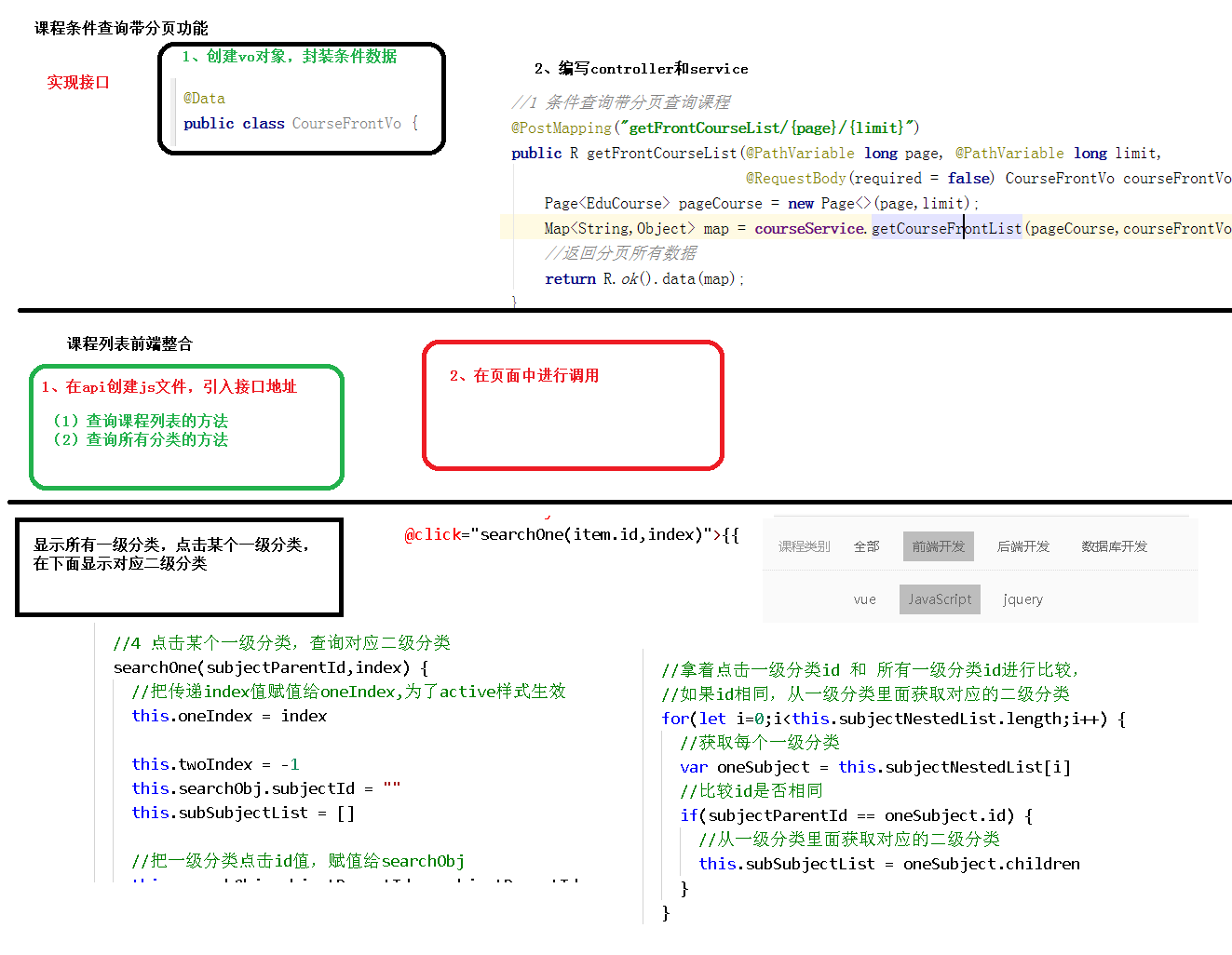一、课程列表后端接口
1、课程列表
(1)课程列表vo类
@ApiModel(value = "课程查询对象", description = "课程查询对象封装")@Datapublic class CourseQueryVo implements Serializable {private static final long serialVersionUID = 1L;@ApiModelProperty(value = "课程名称")private String title;@ApiModelProperty(value = "讲师id")private String teacherId;@ApiModelProperty(value = "一级类别id")private String subjectParentId;@ApiModelProperty(value = "二级类别id")private String subjectId;@ApiModelProperty(value = "销量排序")private String buyCountSort;@ApiModelProperty(value = "最新时间排序")private String gmtCreateSort;@ApiModelProperty(value = "价格排序")private String priceSort;}
(2)课程列表controller
@ApiOperation(value = "分页课程列表")@PostMapping(value = "{page}/{limit}")public R pageList(@ApiParam(name = "page", value = "当前页码", required = true)@PathVariable Long page,@ApiParam(name = "limit", value = "每页记录数", required = true)@PathVariable Long limit,@ApiParam(name = "courseQuery", value = "查询对象", required = false)@RequestBody(required = false) CourseQueryVo courseQuery){Page<EduCourse> pageParam = new Page<EduCourse>(page, limit);Map<String, Object> map = courseService.pageListWeb(pageParam, courseQuery);return R.ok().data(map);}
(3)课程列表service
@Overridepublic Map<String, Object> pageListWeb(Page<EduCourse> pageParam, CourseQueryVo courseQuery) {QueryWrapper<EduCourse> queryWrapper = new QueryWrapper<>();if (!StringUtils.isEmpty(courseQuery.getSubjectParentId())) {queryWrapper.eq("subject_parent_id", courseQuery.getSubjectParentId());}if (!StringUtils.isEmpty(courseQuery.getSubjectId())) {queryWrapper.eq("subject_id", courseQuery.getSubjectId());}if (!StringUtils.isEmpty(courseQuery.getBuyCountSort())) {queryWrapper.orderByDesc("buy_count");}if (!StringUtils.isEmpty(courseQuery.getGmtCreateSort())) {queryWrapper.orderByDesc("gmt_create");}if (!StringUtils.isEmpty(courseQuery.getPriceSort())) {queryWrapper.orderByDesc("price");}baseMapper.selectPage(pageParam, queryWrapper);List<EduCourse> records = pageParam.getRecords();long current = pageParam.getCurrent();long pages = pageParam.getPages();long size = pageParam.getSize();long total = pageParam.getTotal();boolean hasNext = pageParam.hasNext();boolean hasPrevious = pageParam.hasPrevious();Map<String, Object> map = new HashMap<String, Object>();map.put("items", records);map.put("current", current);map.put("pages", pages);map.put("size", size);map.put("total", total);map.put("hasNext", hasNext);map.put("hasPrevious", hasPrevious);return map;}
二、课程详情页
1、vo对象的定义
在项目中很多时候需要把model转换成dto用于网站信息的展示,按前端的需要传递对象的数据,保证model对外是隐私的,例如密码之类的属性能很好地避免暴露在外,同时也会减小数据传输的体积。
CourseWebVo.java
package com.guli.edu.vo;@ApiModel(value="课程信息", description="网站课程详情页需要的相关字段")@Datapublic class CourseWebVo implements Serializable {private static final long serialVersionUID = 1L;private String id;@ApiModelProperty(value = "课程标题")private String title;@ApiModelProperty(value = "课程销售价格,设置为0则可免费观看")private BigDecimal price;@ApiModelProperty(value = "总课时")private Integer lessonNum;@ApiModelProperty(value = "课程封面图片路径")private String cover;@ApiModelProperty(value = "销售数量")private Long buyCount;@ApiModelProperty(value = "浏览数量")private Long viewCount;@ApiModelProperty(value = "课程简介")private String description;@ApiModelProperty(value = "讲师ID")private String teacherId;@ApiModelProperty(value = "讲师姓名")private String teacherName;@ApiModelProperty(value = "讲师资历,一句话说明讲师")private String intro;@ApiModelProperty(value = "讲师头像")private String avatar;@ApiModelProperty(value = "课程类别ID")private String subjectLevelOneId;@ApiModelProperty(value = "类别名称")private String subjectLevelOne;@ApiModelProperty(value = "课程类别ID")private String subjectLevelTwoId;@ApiModelProperty(value = "类别名称")private String subjectLevelTwo;}
2、课程和讲师信息的获取
1)Mapper中关联查询课程和讲师信息
CourseMapper.java
CourseWebVo selectInfoWebById(String courseId);
CourseMapper.xml
<select id="selectInfoWebById" resultType="com.guli.edu.vo.CourseWebVo">SELECTc.id,c.title,c.cover,CONVERT(c.price, DECIMAL(8,2)) AS price,c.lesson_num AS lessonNum,c.cover,c.buy_count AS buyCount,c.view_count AS viewCount,cd.description,t.id AS teacherId,t.name AS teacherName,t.intro,t.avatar,s1.id AS subjectLevelOneId,s1.title AS subjectLevelOne,s2.id AS subjectLevelTwoId,s2.title AS subjectLevelTwoFROMedu_course cLEFT JOIN edu_course_description cd ON c.id = cd.idLEFT JOIN edu_teacher t ON c.teacher_id = t.idLEFT JOIN edu_subject s1 ON c.subject_parent_id = s1.idLEFT JOIN edu_subject s2 ON c.subject_id = s2.idWHEREc.id = #{id}</select>
2)业务层获取数据并更新浏览量
CourseService
接口
/*** 获取课程信息* @param id* @return*/CourseWebVo selectInfoWebById(String id);/*** 更新课程浏览数* @param id*/void updatePageViewCount(String id);
实现
@Overridepublic CourseWebVo selectInfoWebById(String id) {this.updatePageViewCount(id);return baseMapper.selectInfoWebById(id);}@Overridepublic void updatePageViewCount(String id) {Course course = baseMapper.selectById(id);course.setViewCount(course.getViewCount() + 1);baseMapper.updateById(course);}
3)接口层
CourseController
@Autowiredprivate ChapterService chapterService;@ApiOperation(value = "根据ID查询课程")@GetMapping(value = "{courseId}")public R getById(@ApiParam(name = "courseId", value = "课程ID", required = true)@PathVariable String courseId){//查询课程信息和讲师信息CourseWebVo courseWebVo = courseService.selectInfoWebById(courseId);//查询当前课程的章节信息List<ChapterVo> chapterVoList = chapterService.nestedList(courseId);return R.ok().data("course", courseWebVo).data("chapterVoList", chapterVoList);}



